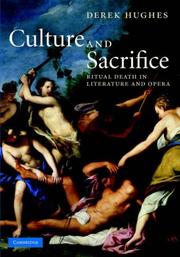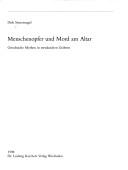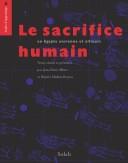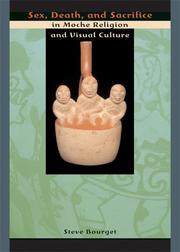| Listing 1 - 8 of 8 |
Sort by
|
Book
ISBN: 9781107402911 1107402913 Year: 2011 Publisher: Cambridge : Cambridge University Press,
Abstract | Keywords | Export | Availability | Bookmark
 Loading...
Loading...Choose an application
- Reference Manager
- EndNote
- RefWorks (Direct export to RefWorks)

ISBN: 9780521867337 0521867339 Year: 2007 Publisher: Cambridge Cambridge University Press,
Abstract | Keywords | Export | Availability | Bookmark
 Loading...
Loading...Choose an application
- Reference Manager
- EndNote
- RefWorks (Direct export to RefWorks)
Human sacrifice has fascinated Western writers since the beginnings of European literature. It is prominent in Greek epic and tragedy, and returned to haunt writers after the discovery of the Aztec mass sacrifices. It has been treated by some of the greatest creative geniuses, including Shakespeare and Wagner, and was a major topic in the works of many Modernists, such as D. H. Lawrence and Stravinsky. In literature, human sacrifice is often used to express a writer's reaction to the residue of barbarism in his own culture. The meaning attached to the theme therefore changes profoundly from one period to another, yet it remains as timely an image of cultural collapse as it did over two thousand years ago. Drawing on sources from literature and music, Derek Hughes examines the representation of human sacrifice in Western culture from the Iliad to the invasion of Iraq.
Comparative literature --- Thematology --- Music --- Human sacrifice in literature --- Human sacrifice in art --- Human sacrifice in art. --- Human sacrifice in literature.

ISBN: 3895000515 Year: 1998 Publisher: Wiesbaden Reichert
Abstract | Keywords | Export | Availability | Bookmark
 Loading...
Loading...Choose an application
- Reference Manager
- EndNote
- RefWorks (Direct export to RefWorks)
Human sacrifice in art. --- Mythology, Greek, in art. --- Relief (Sculpture), Etruscan --- Sepulchral monuments --- Greek influences. --- Themes, motives.
Book
ISBN: 9782875620217 2875620215 9791036560699 Year: 2013 Volume: 2 Publisher: Liège Presses universitaires de Liège
Abstract | Keywords | Export | Availability | Bookmark
 Loading...
Loading...Choose an application
- Reference Manager
- EndNote
- RefWorks (Direct export to RefWorks)
Le thème du sacrifice humain ne peut laisser indifférent et continue de susciter bien des interrogations, entre fascination et dégoût. Historiens et anthropologues se divisent sur l’historicité supposée du phénomène. Pour sortir de l’impasse, cet ouvrage se penche sur la manière dont les cultures se représentent le sacrifice humain, le leur ou celui des autres, fût-il réel ou symbolique. Comment une société fait-elle face à ce qui est - ou ce qu’elle croit être - son passé cruel et sanglant ? Quelles sont les valeurs dont le sacrifice humain, et d’autres concepts proches, comme l’anthropophagie, se trouvent chargés en vertu des normes indigènes ? Comment ces perceptions ont-elles persisté dans la longue durée et comment se sont-elles adaptées aux idéologies changeantes ? Le coeur du volume est consacré au dossier hellénique, remarquablement documenté par les Grecs eux-mêmes. À ce dossier répondent en contrepoint plusieurs articles sur la Chine ancienne, les Aztèques, et la Rome antique, qui projettent un regard différent et sont autant de raisons de remettre cent fois sur le métier cet objet fascinant. The topic of human sacrifice, which tends to provoke both fascination and disgust, leaves few people indifferent and remains a highly contested academic issue. The present volume is not concerned with the historical reality of human sacrifice, a question that continues to divide historians and anthropologists. Rather, it is interested in how different ancient cultures represented human sacrifice differently, both theirs and that of others, either as an event or a symbol. How does a society confront what might have been -or what it thought was- its own cruel and bloody past? What are the culturally specific values through which human sacrifice was understood in each group, and how did they differ in the case of other related practices, such as anthropophagy? How have these perceptions changed over time, and how have they adapted to the transformations of…
Human sacrifice --- Sacrifice humain --- Cross-cultural studies --- History --- Etudes transculturelles --- Histoire --- 292.34 --- Religion Classical Greek and Roman Offerings, sacrifices, penances --- Human sacrifice in literature. --- Human sacrifice in art. --- Ethnology. --- Religions --- Mensenoffers. --- Cross-cultural studies. --- History. --- Religious aspects --- Comparative studies --- Religion --- sacrifices humains

ISBN: 1841717207 Year: 2005 Volume: 1429 Publisher: Oxford : John and Erica Hedges,
Abstract | Keywords | Export | Availability | Bookmark
 Loading...
Loading...Choose an application
- Reference Manager
- EndNote
- RefWorks (Direct export to RefWorks)
Mochica art. --- Mochica pottery. --- Mochica Indians --- Human sacrifice in art. --- Art mochica --- Céramique mochica --- Mochica (Indiens) --- Sacrifice humain dans l'art --- Antiquities. --- Social life and customs. --- Antiquités --- Moeurs et coutumes --- Moche (Peru) --- Moche (Pérou) --- Céramique mochica --- Antiquités --- Moche (Pérou)

ISBN: 2952372608 Year: 2005 Volume: 6. Publisher: Paris Soleb
Abstract | Keywords | Export | Availability | Bookmark
 Loading...
Loading...Choose an application
- Reference Manager
- EndNote
- RefWorks (Direct export to RefWorks)
Human sacrifice --- Funeral rites and ceremonies, Ancient. --- Rites and ceremonies --- Human sacrifice in art --- Sacrifice humain --- Funérailles --- Rites et cérémonies --- Sacrifice humain dans l'art --- History. --- History --- Comparative studies --- Histoire --- Etudes comparatives --- Funérailles --- Rites et cérémonies --- Comparative studies.

ISBN: 0292791836 0292712790 Year: 2006 Publisher: Austin : University of Texas Press,
Abstract | Keywords | Export | Availability | Bookmark
 Loading...
Loading...Choose an application
- Reference Manager
- EndNote
- RefWorks (Direct export to RefWorks)
The Moche people who inhabited the north coast of Peru between approximately 100 and 800 AD were perhaps the first ancient Andean society to attain state-level social complexity. Although they had no written language, the Moche created the most elaborate system of iconographic representation of any ancient Peruvian culture. Amazingly realistic figures of humans, animals, and beings with supernatural attributes adorn Moche pottery, metal and wooden objects, textiles, and murals. These actors, which may have represented both living individuals and mythological beings, appear in scenes depicting ritual warfare, human sacrifice, the partaking of human blood, funerary rites, and explicit sexual activities. In this pathfinding book, Steve Bourget raises the analysis of Moche iconography to a new level through an in-depth study of visual representations of rituals involving sex, death, and sacrifice. He begins by drawing connections between the scenes and individuals depicted on Moche pottery and other objects and the archaeological remains of human sacrifice and burial rituals. He then builds a convincing case for Moche iconography recording both actual ritual activities and Moche religious beliefs regarding the worlds of the living, the dead, and the afterlife. Offering a pioneering interpretation of the Moche worldview, Bourget argues that the use of symbolic dualities linking life and death, humans and beings with supernatural attributes, and fertility and social reproduction allowed the Moche to create a complex system of reciprocity between the world of the living and the afterworld. He concludes with an innovative model of how Moche cosmological beliefs played out in the realms of rulership and political authority.
Mochica pottery --- Mochica Indians --- Sex in art. --- Death in art. --- Human sacrifice in art. --- Themes, motives. --- Rites and ceremonies. --- Social life and customs. --- Peru --- Antiquities. --- Pottery, Mochica --- Pottery, Peruvian --- Death --- Sex in the arts --- Sexuality in art --- Moche Indians --- Muchik Indians --- Indians of South America --- Yunca Indians --- Pottery
Book
ISBN: 9789061539513 Year: 2010 Publisher: Bruxelles : Fonds Mercator,
Abstract | Keywords | Export | Availability | Bookmark
 Loading...
Loading...Choose an application
- Reference Manager
- EndNote
- RefWorks (Direct export to RefWorks)
Exhibitions --- Incas --- History --- Human sacrifice in art --- Human sacrifice --- Inca art --- Indians of South America --- American aborigines --- American Indians --- Indigenous peoples --- Inca Indians --- Art, Inca --- Sacrifice, Human --- Themes, motives --- Material culture --- Rites and ceremonies --- Ethnology --- Art --- Andes --- Andean Mountain Range --- Andean Mountains --- Andean Range --- Andes Mountain Range --- Andes Mountain Ranges --- Andes Mountains --- Andes Range --- Andes Ranges --- Anti (Mountains) --- Antis (Mountains) --- Cordillera de los Andes --- Los Andes --- The Andes --- Antiquities --- Art, Latin American --- Sacrifice --- Ritual murder
| Listing 1 - 8 of 8 |
Sort by
|

 Search
Search Feedback
Feedback About UniCat
About UniCat  Help
Help News
News